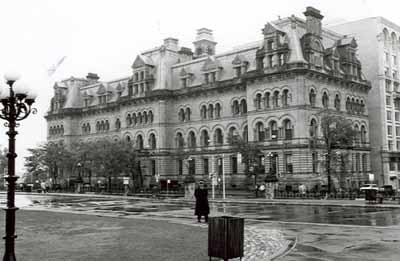Office of the Prime Minister and Privy Council
Classified Federal Heritage Building
Ottawa, Ontario

Corner view
(© Ian Doull, AHB, Parks Canada | Parcs Canada, 1987)
Address :
80 Wellington Street, Ottawa, Ontario
Recognition Statute:
Treasury Board Policy on Management of Real Property
Designation Date:
1988-09-01
Dates:
-
1883 to 1889
(Construction)
Event, Person, Organization:
-
Thomas Fuller
(Architect)
Custodian:
Public Works and Government Services Canada
FHBRO Report Reference:
87-040
DFRP Number:
08833 00
Description of Historic Place
Prominently situated opposite Parliament Hill, the Office of the Prime Minister and Privy Council is one of the finest federal examples of a Second Empire office building. A robust, three-and-a-half stories high, its limestone pavilion massing, rows of round arched windows and copper mansard roof are complimented by a rich decorative vocabulary. The designation is confined to the footprint of the building.
Heritage Value
The Office of the Prime Minister and Privy Council has been designated a Classified heritage property because of its historical associations with the growth of the new federal government in the first decades following Confederation, and because of its impressive architectural design and craftsmanship. The building marked an important first phase in the expansion of the government precinct beyond the boundaries of Parliament Hill, and continues to be a major element in establishing the institutional and ceremonial character of its urban environment.
Sources:
Ian Doull, Langevin Block, Ottawa, Ontario, Federal Heritage Building Review Office Building Report 87-040.
The Office of the Prime Minister and Privy Council, Ottawa, Ontario, Heritage Character Statement, 87-040.
Character-Defining Elements
Key elements that define the heritage character of this property include
-its well-designed and richly detailed exterior, executed in the Second Empire style, with traces of the Romanesque influence;
-the highly articulated, symmetrical façades;
-the characteristic mansard roofs, which were used to emphasize the three-dimensional quality of the silhouette;
-the central entrance pavilion and two end pavilions, with recessed façades between;
-the end façades, which continue the vocabulary of the front elevation, but are asymmetrical, due in part to the irregularities of the site.
-the layout, finishes and decorative treatments of its interior;
-the richness and general symmetry of the north elevation, which is notable particularly for its entrance lobby, staircase, and corridors;
-the prominence of its siting.
Heritage Character Statement
Disclaimer -
The heritage character statement was developed by FHBRO to explain the reasons for the designation of a federal heritage building and what it is about the building that makes it significant (the heritage character). It is a key reference document for anyone involved in planning interventions to federal heritage buildings and is used by FHBRO in their review of interventions.
The Office of the Prime Minister and Privy Council was constructed in 1883-89 to the designs of Dominion chief architect Thomas Fuller. One of the finest surviving examples of the work of Fuller, and of federal government buildings in the Second Empire style, it has gained additional prestige from its conversion in 1975-77 from departmental offices to house the offices of the Prime Minister and Privy Council. The custodial department is Public Works Canada. See FHBRO Building Report 87-40.
Reasons for Designation
The Office of the Prime Minister and Privy Council has been designated a Classified heritage property because of its historical associations with the growth of the new federal government in the first decades following Confederation, and because of its impressive architectural design and craftsmanship. It marked an important first phase in the expansion of the government precinct beyond the boundaries of Parliament Hill, and it continues to be a major element in establishing the institutional and ceremonial character of its urban environment.
Character Defining Elements
The heritage character of this property is defined by its well designed and richly detailed exterior; the layout, finishes and decorative treatments of its interior; and the prominence of its siting.
The building is a relatively late example of the Second Empire style, with traces of the Romanesque influence that was coming into vogue at the time. The Second Empire style was marked by highly articulated façades, symmetrically disposed. The characteristic mansard roofs were used to emphasize the three-dimensional quality of the silhouette. In the case of the Office of the Prime Minister and Privy Council, the main north elevation is marked by a central entrance pavilion and two end pavilions, with recessed façades between. These vertical elements are tied together by the strong horizontal layering of the building, from the rusticated stone base of the ground floor to the arched window openings in the smooth dressed stone of the second and third floors, to the heavy cornice line and elaborate dormers of the mansard roof. The end façades continue the vocabulary of the front elevation, but are asymmetrical, due in part to the irregularities of the site.
These façades have survived relatively intact, and it is important that all the various components, including the finely worked sandstone, the doors and windows, and the copper roof, be carefully preserved. More extensive repair or restoration, if required, should be carried out only after meticulous analysis of present conditions, and should be historically accurate in terms of materials and detailing.
The interior of the building continues the richness and general symmetry of the north elevation, and is notable particularly for its entrance lobby, staircase, and corridors. Historic finishes and decorative treatments, particularly in these areas, should be protected and maintained. Some ongoing changes will be required in response to functional requirements, particularly within the office areas; any new work should be designed to be distinct from, but sympathetic to, the original design, so as to preserve the historical and architectural integrity of the property.
1988.06.30